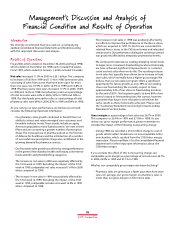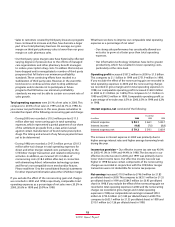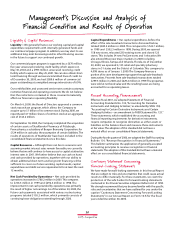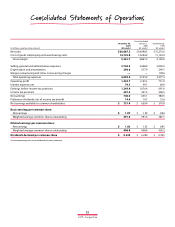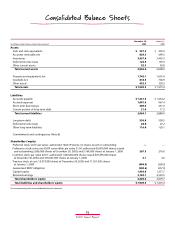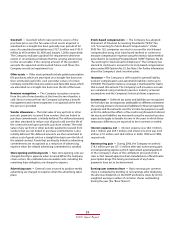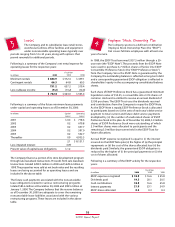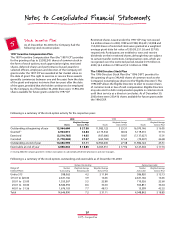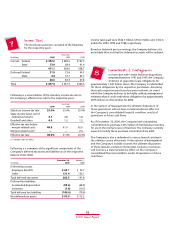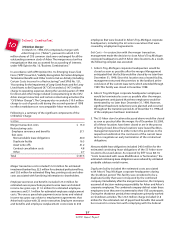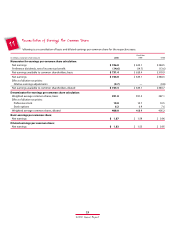CVS 2000 Annual Report Download - page 29
Download and view the complete annual report
Please find page 29 of the 2000 CVS annual report below. You can navigate through the pages in the report by either clicking on the pages listed below, or by using the keyword search tool below to find specific information within the annual report.
Goodwill ~ Goodwill, which represents the excess of the
purchase price over the fair value of net assets acquired, is
amortized on a straight-line basis generally over periods of 40
years. Accumulated amortization was $127.3 million and $105.0
million as of December 30, 2000 and January 1, 2000, respectively.
The Company evaluates goodwill for impairment whenever
events or circumstances indicate that the carrying amount may
not be recoverable. If the carrying amount of the goodwill
exceeds the expected undiscounted future cash flows, the
Company records an impairment loss.
Other assets ~ Other assets primarily include patient prescription
file purchases, which are amortized on a straight-line basis over
their estimated useful life, cash surrender values of certain
Company-owned life insurance policies and favorable leases, which
are amortized on a straight-line basis over the life of the lease.
Revenue recognition ~ The Company recognizes revenue
from the sale of merchandise at the time the merchandise is
sold. Service revenue from the Company’s pharmacy benefit
management and internet segments is recognized at the time
the service is provided.
Vendor allowances ~ The total value of any up-front or other
periodic payments received from vendors that are linked to
purchase commitments is initially deferred.The deferred amounts
are then amortized to reduce cost of goods sold over the life of
the contract based upon periodic purchase volume. The total
value of any up-front or other periodic payments received from
vendors that are not linked to purchase commitments is also
initially deferred. The deferred amounts are then amortized to
reduce cost of goods sold on a straight-line basis over the life of
the related contract. Funds that are directly linked to advertising
commitments are recognized as a reduction of advertising
expense when the related advertising commitment is satisfied.
Store opening and closing costs ~ New store opening costs are
charged directly to expense when incurred. When the Company
closes a store, the estimated unrecoverable costs, including the
remaining lease obligation, are charged to expense.
Advertising costs ~ External costs incurred to produce media
advertising are charged to expense when the advertising takes
place.
Stock-based compensation ~ The Company has adopted
Statement of Financial Accounting Standards (“SFAS”) No.
123,“Accounting for Stock-Based Compensation.” Under
SFAS No. 123, companies can elect to account for stock-based
compensation using a fair value based method or continue to
measure compensation expense using the intrinsic value method
prescribed in Accounting Principles Board (“APB”) Opinion No. 25,
“Accounting for Stock Issued to Employees.”The Company has
elected to continue to account for its stock-based compensation
plans under APB Opinion No.25. See Note 5 for further information
about the Company’s stock incentive plans.
Insurance ~ The Company is self-insured for general liability,
workers’ compensation and automobile liability claims up to
$500,000.Third party insurance coverage is maintained for claims
that exceed this amount.The Company’s self-insurance accruals
are calculated using standard insurance industry actuarial
assumptions and the Company’s historical claims experience.
Income taxes ~ Deferred tax assets and liabilities are recognized
for the future tax consequences attributable to differences between
the carrying amount of assets and liabilities for financial reporting
purposes and the amounts used for income tax purposes as well
as for the deferred tax effects of tax credit carryforwards. Deferred
tax assets and liabilities are measured using the enacted tax rates
expected to apply to taxable income in the years in which those
temporary differences are expected to be recovered or settled.
Interest expense, net ~ Interest expense was $84.1 million,
$66.1 million and $69.7 million and interest income was $4.8
million, $7.0 million and $8.8 million in 2000, 1999 and 1998,
respectively.
Nonrecurring gain ~ During 2000, the Company recorded a
$19.2 million pre-tax ($11.5 million after-tax) nonrecurring gain
in total operating expenses, which represented a partial payment
of the Company’s share of the settlement proceeds from a
class action lawsuit against certain manufacturers of brand name
prescription drugs. The timing and amount of any future
payments have yet to be determined.
Earnings per common share ~ Basic earnings per common
share is computed by dividing: (i) net earnings, after deducting
the after-tax dividends on the ESOP preference stock, by (ii) the
weighted average number of common shares outstanding
during the year (the “Basic Shares”).
27
2000 Annual Report



